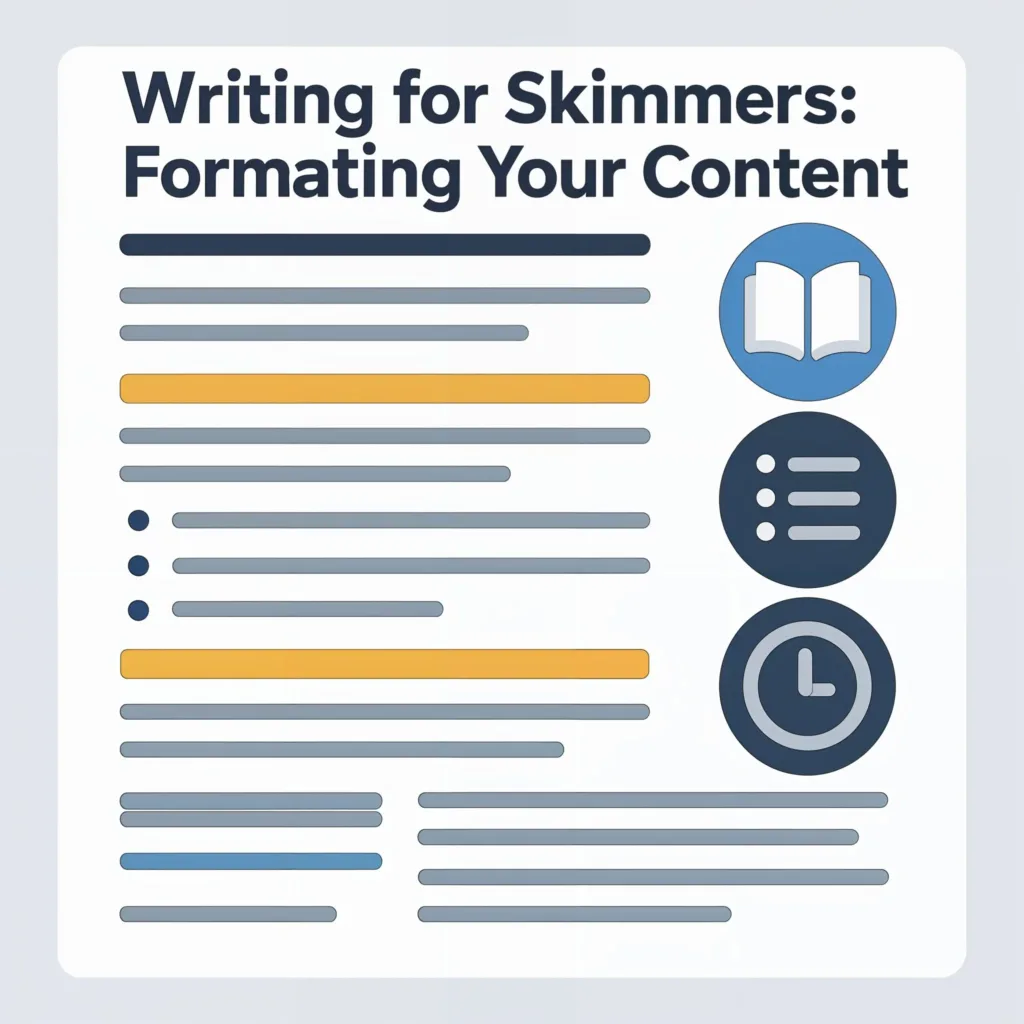
Writing for Skimmers: Formatting Your Content
If you want to connect with modern readers, you must master writing for skimmers. Online audiences have short attention spans and limited time. They scan pages for key points instead of reading every word. Therefore, formatting your content for skimmers is not just helpful—it’s essential for engagement. In this guide, you’ll learn why skimmer-friendly content matters, plus practical ways to apply writing for skimmers to your blog or website.
Why Writing for Skimmers Matters More Than Ever
More than half of your visitors will skim your content. They’re looking for answers fast. When they land on a wall of text, they bounce. But when they see well-structured content with clear headings, short paragraphs, and bullet points, they stick around. That’s why writing for skimmers boosts user experience and SEO performance. Search engines reward pages with lower bounce rates and higher dwell times. This means that the better you format your content, the better it ranks. Furthermore, formatting builds trust. Readers appreciate when you respect their time by making your insights easy to digest. Use formatting to guide them from start to finish.
How to Structure Content When Writing for Skimmers
The core of writing for skimmers is smart structure. Begin with an irresistible headline and an opening paragraph that hooks attention. Next, break your content into sections with keyword-rich subheadings. Use H2s and H3s strategically to help readers jump to what matters. Keep paragraphs short—ideally two to three sentences. Long blocks of text overwhelm readers and make them exit your page. Instead, mix short sentences with lists, bullet points, and bolded keywords. This gives skimmers multiple entry points into your ideas. Equally important, use transition words to maintain flow. Visual elements like images, charts, and infographics can reinforce your message and provide needed breaks. End each section with a clear takeaway or action step. The easier you make it to skim, the more readers will consume and share your work.
Best Practices for Writing for Skimmers in Digital Marketing
To master writing for skimmers, adopt habits that keep your content engaging yet clear. Use conversational language. Avoid jargon unless it’s relevant to your audience. Highlight important phrases with bold or italics. When possible, add quote callouts or tweetable snippets to emphasize key insights. Consistency is crucial—format every post with the same attention to structure. Use internal links to guide skimmers deeper into related content. This boosts session time and helps your SEO. In addition, include CTAs (calls to action) within your content, not just at the end. A skimmer might never reach the conclusion, so you want your main offer visible throughout. Finally, always preview your posts on mobile. Many readers skim from their phones, so ensure your design is responsive and easy to navigate.
Examples of Writing for Skimmers That Work
Some of the best blogs in digital marketing excel at writing for skimmers. They use headlines packed with keywords and power words that grab attention. They break up text with visuals and include lists for quick reading. For example, a well-structured how-to guide starts with a brief introduction, includes a table of contents, and then delivers actionable steps under clear subheadings. Each step may start with a bold statement that conveys the takeaway instantly. If you study these examples, you’ll notice how they anticipate what a skimmer wants: clear answers fast. Apply this mindset to every piece of content you write, whether it’s a blog, email, or landing page.
Conclusion: Why Writing for Skimmers Builds Better Content
Writing for skimmers isn’t about dumbing down your ideas. It’s about respecting your audience’s time and delivering value efficiently. Structured, skimmer-friendly content keeps readers on your site longer, improves SEO, and boosts conversions. More importantly, it shows that you care about the reader experience. The next time you draft a post, ask yourself: “Is this scannable? Are my key points obvious?” Keep refining your approach. Over time, you’ll build a reputation for content that’s not just informative but incredibly easy to read. That’s how you grow your audience and stand out in today’s competitive digital world.